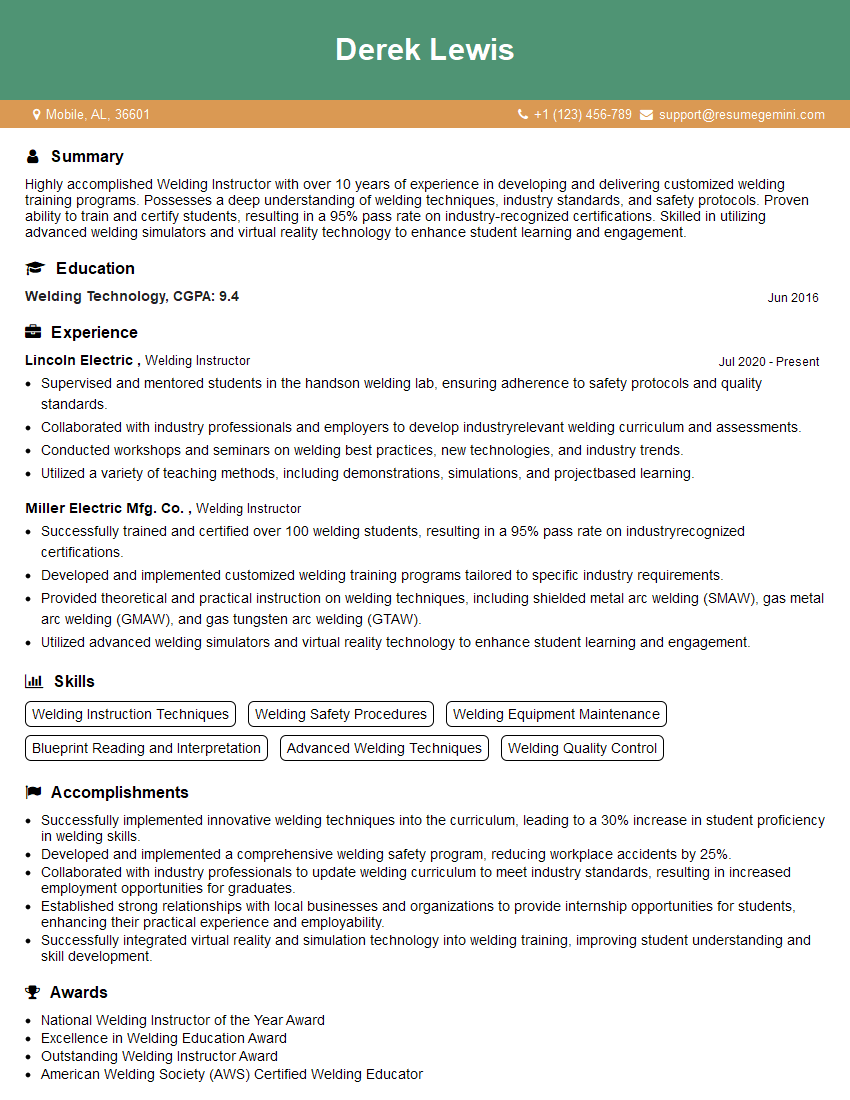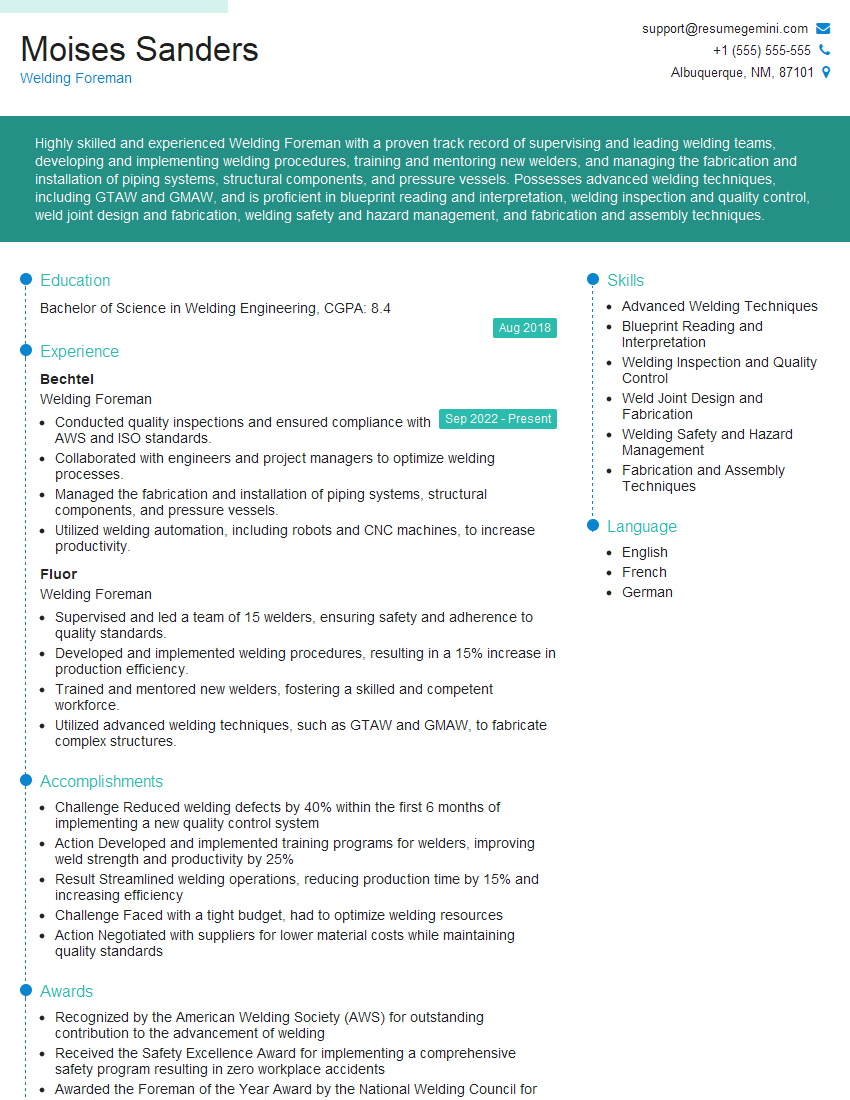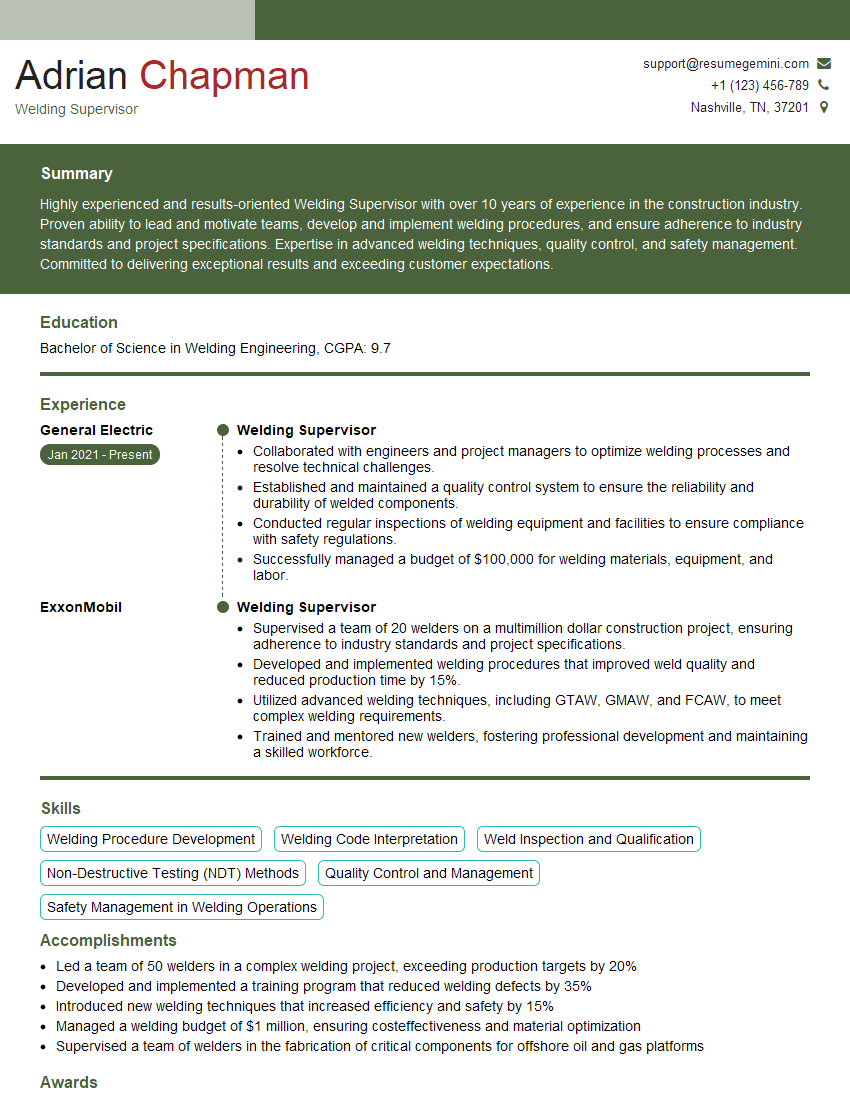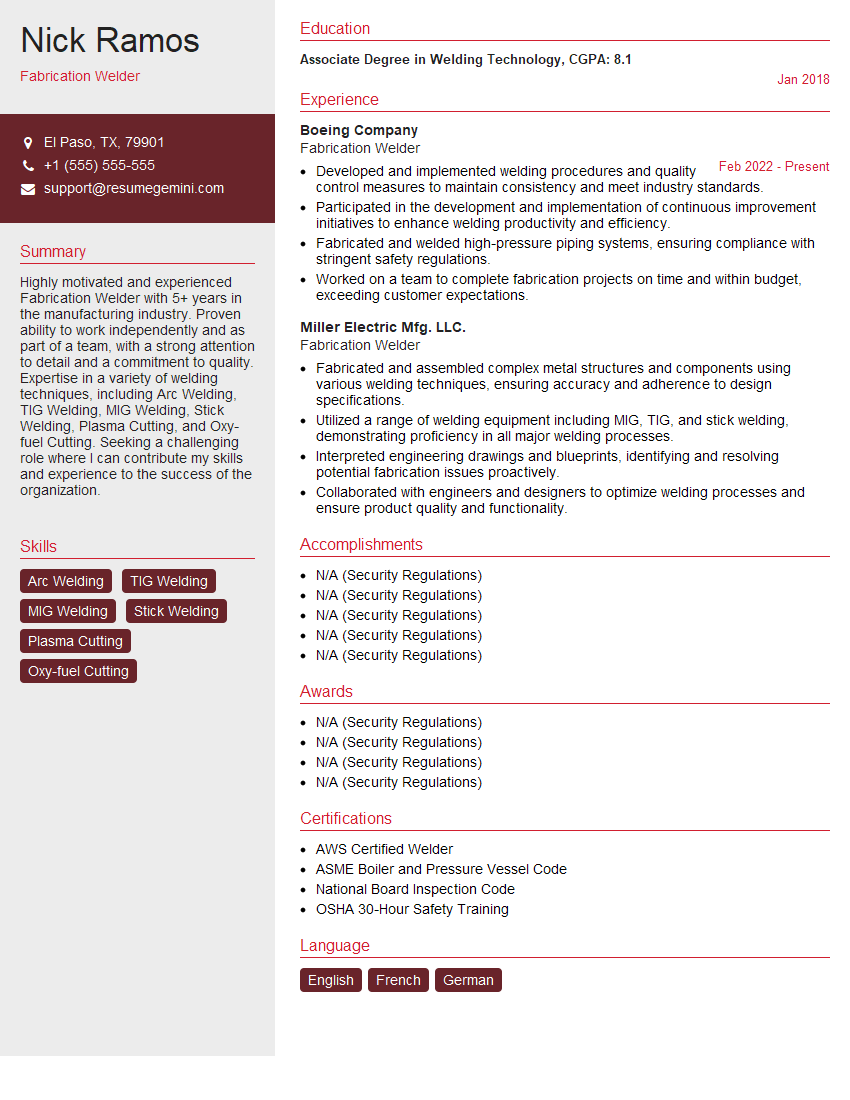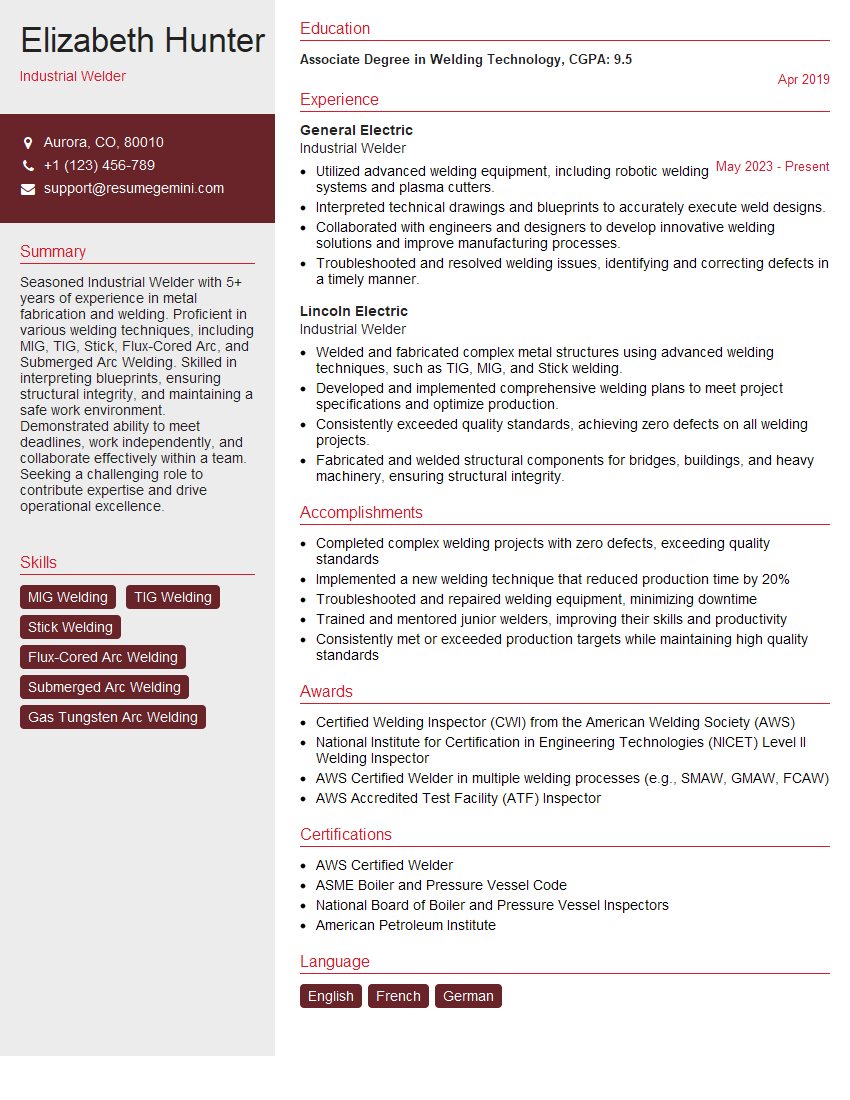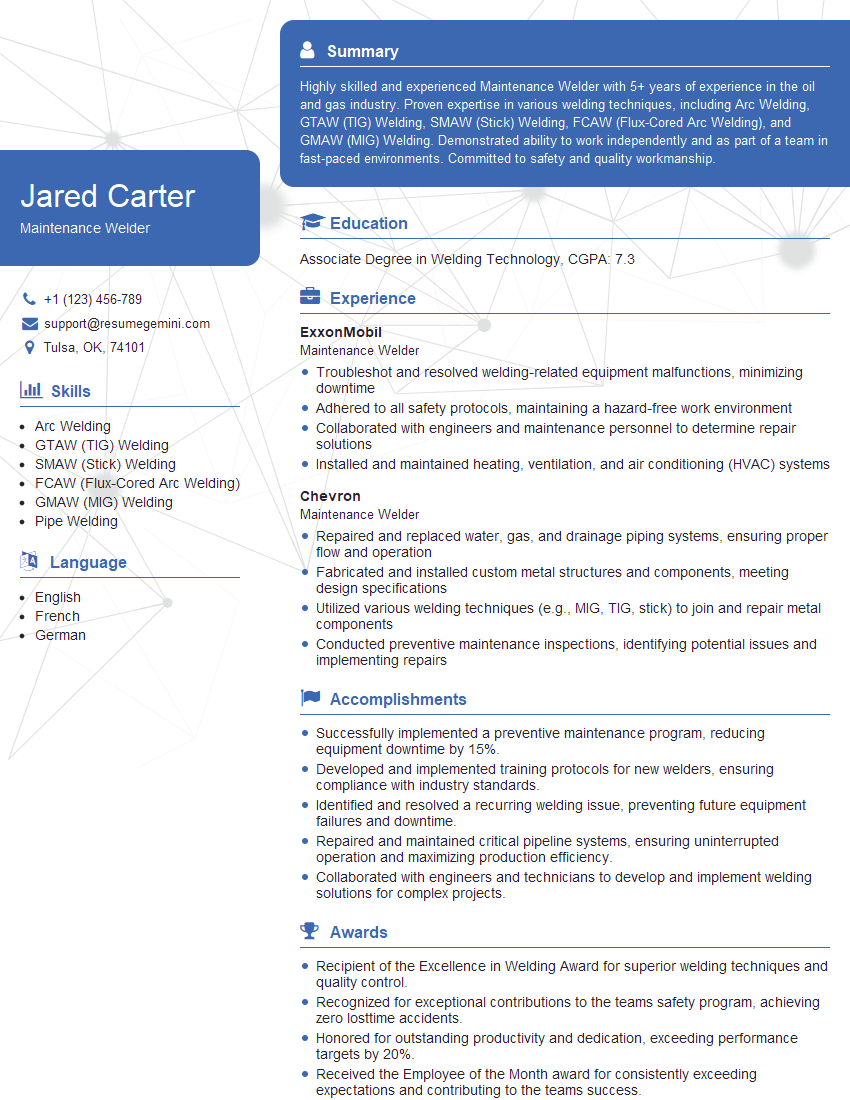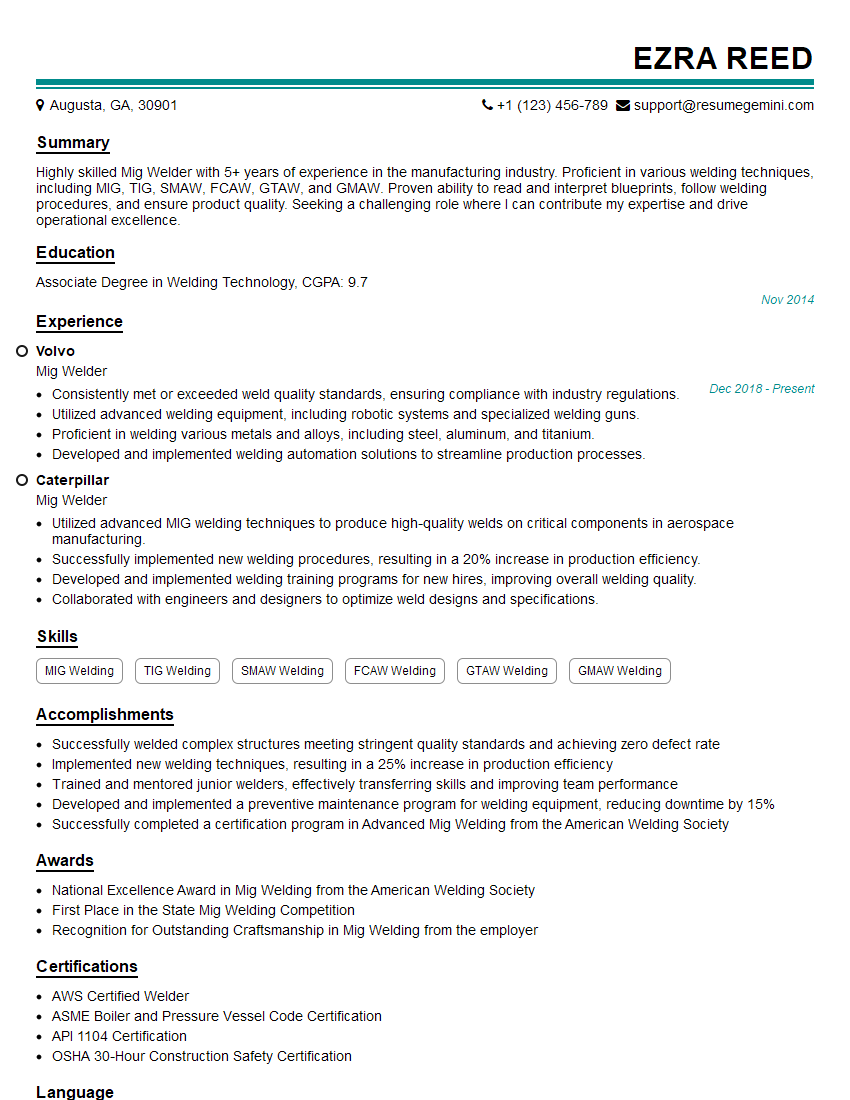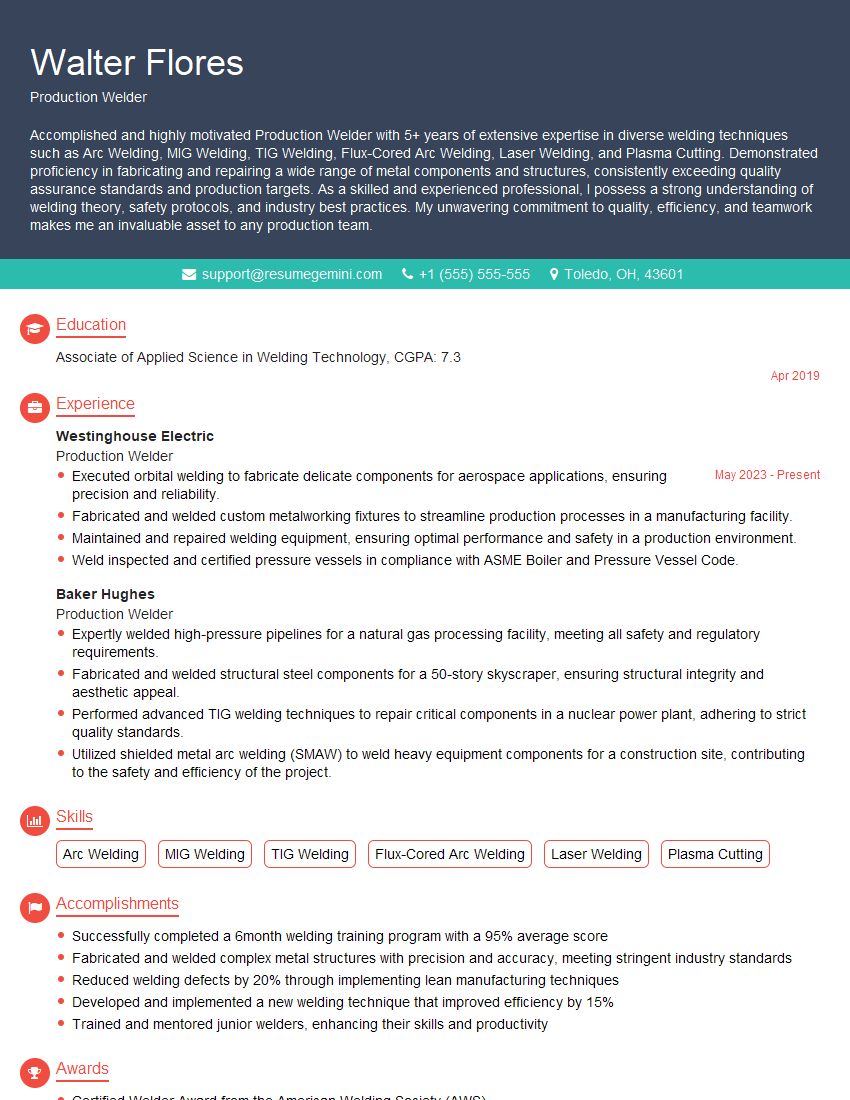Cracking a skill-specific interview, like one for Wirefeed Welding, requires understanding the nuances of the role. In this blog, we present the questions you’re most likely to encounter, along with insights into how to answer them effectively. Let’s ensure you’re ready to make a strong impression.
Questions Asked in Wirefeed Welding Interview
Q 1. Explain the difference between GMAW and FCAW welding processes.
Both GMAW (Gas Metal Arc Welding), commonly known as MIG welding, and FCAW (Flux-Cored Arc Welding) are wirefeed welding processes that use a continuously fed consumable electrode to create a weld. The key difference lies in how the shielding gas is provided.
In GMAW, a separate shielding gas (usually argon or a mixture of argon and carbon dioxide) is supplied from a gas cylinder to protect the weld pool from atmospheric contamination. This ensures a clean and high-quality weld.
FCAW, on the other hand, utilizes a flux-cored wire. This wire contains a core of fluxing material that generates a shielding gas and slag during the welding process. This eliminates the need for an external gas cylinder, making FCAW more portable and suitable for outdoor applications where shielding gas might be affected by wind.
Think of it like this: MIG welding is like using a spray paint can with a separate protective shield, while FCAW is like using a paint can with its own built-in protective layer.
Q 2. Describe the shielding gas commonly used in MIG welding and its purpose.
The most commonly used shielding gas in MIG welding is a mixture of 75% Argon and 25% Carbon Dioxide (Ar/CO2). Other mixtures exist depending on the metal being welded and desired weld characteristics.
The purpose of the shielding gas is to protect the molten weld pool from atmospheric contamination, specifically oxygen and nitrogen. These atmospheric gases can react with the molten metal, leading to porosity (tiny holes in the weld), embrittlement (making the weld weaker and more brittle), and overall poor weld quality. The shielding gas creates a protective blanket around the weld pool, ensuring a clean and sound fusion between the base metals.
Q 3. What are the different wire feed speeds and their effects on weld quality?
Wire feed speed is a crucial parameter in MIG welding, directly influencing the weld bead characteristics and overall quality. It is typically measured in inches per minute (IPM).
- Low wire feed speeds result in a larger weld bead with deeper penetration. However, it could lead to excessive heat input, potentially causing burn-through or distortion of the base material.
- High wire feed speeds produce smaller, narrower weld beads with shallower penetration. This is useful for thin materials where burn-through is a concern. However, using a very high speed might result in insufficient fusion and lack of penetration.
Selecting the appropriate wire feed speed depends on several factors, including wire diameter, amperage, voltage, material thickness, and desired weld profile. Improper wire feed speed can significantly affect the weld’s mechanical properties and appearance. For instance, inconsistent wire feed speed can cause inconsistent weld bead geometry, leading to flaws such as undercutting or porosity.
Q 4. How do you select the appropriate wire diameter for a given application?
Choosing the correct wire diameter is essential for optimal welding performance and quality. The wire diameter must be matched to the amperage and thickness of the material being welded.
Generally, thinner wires (e.g., 0.023-inch, 0.030-inch) are used for thinner materials and lower amperages, providing better control and reducing the risk of burn-through. Thicker wires (e.g., 0.035-inch, 0.045-inch) are used for thicker materials and higher amperages, offering greater penetration and faster welding speeds. Using the wrong wire diameter can lead to various problems such as poor penetration, excessive spatter, or burn-through.
Consult the manufacturer’s specifications for the specific wire type and its recommended amperage range for optimal results. A good rule of thumb is to select a wire diameter that aligns with the welding current capacity of your machine and the thickness of the metal you are joining.
Q 5. Explain the importance of maintaining proper voltage and amperage in wirefeed welding.
Maintaining proper voltage and amperage is critical for achieving a quality weld in wirefeed welding. These two parameters are closely intertwined and directly influence the arc characteristics and heat input.
Voltage controls the arc length. An excessively short arc can result in sticking and spatter, while a long arc leads to increased porosity and poor penetration. Amperage controls the heat input, influencing the penetration depth and weld bead width. Too low amperage can result in insufficient penetration, while too high amperage leads to burn-through or excessive distortion.
The ideal voltage and amperage settings depend on several factors, including the wire diameter, shielding gas type, material thickness, and welding speed. Improper settings can result in weld defects such as porosity, lack of fusion, undercut, or excessive spatter. Monitoring the voltage and amperage during welding using the welder’s built-in meters is crucial to ensure consistency and quality.
Q 6. Describe the process of setting up a wirefeed welder for different materials (steel, aluminum, stainless steel).
Setting up a wirefeed welder for different materials involves adjusting several parameters to achieve proper arc characteristics and weld penetration. Here’s a general overview:
- Steel: Typically uses a solid wire (e.g., ER70S-6) and a shielding gas mixture like 75% Argon/25% CO2 or 100% CO2. Adjust voltage and amperage according to the material thickness and desired penetration.
- Aluminum: Requires a special aluminum wire (e.g., ER4043, ER5356) and a shielding gas like 100% Argon or a mixture of Argon and Helium. Aluminum welds at a lower voltage and higher amperage compared to steel due to its higher thermal conductivity. Cleanliness is critical; aluminum oxide can severely impact weld quality.
- Stainless Steel: Typically uses a stainless steel wire (e.g., 308LSi) and shielding gas like 100% Argon or Argon/CO2 mixtures. Choosing the correct filler metal is crucial to match the base metal’s chemical composition and ensure good corrosion resistance. Properly adjusting voltage and amperage to avoid porosity and hot cracking is critical.
In all cases, proper cleaning of the base metal surfaces is crucial before welding. Always consult the manufacturer’s recommendations for the specific wire and gas combination you’re using to ensure optimal results.
Q 7. What are the common weld defects associated with wirefeed welding, and how can they be prevented?
Several common weld defects can occur in wirefeed welding. Understanding their causes and implementing preventive measures is crucial for producing high-quality welds.
- Porosity: Caused by gas entrapment in the weld pool, often due to improper shielding gas coverage or moisture contamination in the wire or base material. Prevention: Use the correct shielding gas, maintain a proper arc length, and ensure the wire and base metal are clean and dry.
- Lack of Fusion: Occurs when the weld metal doesn’t properly fuse with the base material, resulting in a weak joint. Prevention: Proper joint preparation, sufficient heat input (amperage and travel speed), and proper cleaning of the base material before welding are all crucial.
- Undercut: A groove formed at the edge of the weld, weakening the joint. Prevention: Proper travel speed, minimizing the arc length, and using the correct welding parameters are key.
- Spatter: Small molten droplets expelled from the weld pool. Prevention: Maintaining the correct arc length, using the correct wire feed speed and amperage, and ensuring proper shielding gas coverage are all essential.
- Burn-through: A hole melted through the base material due to excessive heat input. Prevention: Reduce amperage, increase travel speed, or use a smaller wire diameter.
Regular inspection of welds through visual examination and potentially non-destructive testing (NDT) methods is vital for identifying and addressing any defects before they compromise the integrity of the weld.
Q 8. Explain the concept of short-circuiting transfer and pulsed spray transfer in MIG welding.
MIG welding, or Gas Metal Arc Welding (GMAW), utilizes several transfer modes to deliver molten weld metal to the workpiece. Short-circuiting transfer and pulsed spray transfer are two popular choices, each suited to different applications.
Short-Circuiting Transfer: This method is ideal for thin materials and delicate work. The wire repeatedly touches the workpiece, creating a short circuit that generates heat and melts the wire. Think of it like repeatedly tapping a tiny blob of molten metal onto the joint. This process produces a low spatter, smooth weld bead, but penetration is generally lower than other methods. It’s excellent for sheet metal fabrication or automotive repair where minimizing distortion is crucial.
Pulsed Spray Transfer: This advanced technique bridges the gap between short-circuiting and conventional spray transfer. It uses a pulsed current, rapidly switching between high current pulses (for melting and transferring the metal) and low current background (for preventing short-circuiting). This results in a spray transfer pattern with much less spatter than continuous spray transfer while also achieving deeper penetration than short-circuiting. It’s suitable for a wider range of materials and thicknesses compared to short-circuiting, offering a good balance between quality and speed. Imagine it as controlled bursts of spray, very precisely deposited.
Q 9. How do you adjust the wire feed speed to achieve proper penetration and bead width?
Wire feed speed is critical for controlling weld bead characteristics. Increasing the wire feed speed generally increases the amount of weld metal deposited, leading to a wider bead and potentially deeper penetration. However, excessively high speed can cause undercut (a groove at the weld toe), poor fusion, and excessive spatter.
To achieve proper penetration and bead width, you need to consider several factors including the material thickness, the chosen welding parameters (voltage and amperage), and the shielding gas. You’ll often need to fine-tune the wire feed speed experimentally. Starting with a lower speed and gradually increasing it while closely monitoring the bead profile is the safest approach.
Example: Welding a thicker steel plate might require a higher wire feed speed compared to a thinner plate to achieve sufficient penetration. Visual inspection and even destructive testing (e.g., cross-section analysis) are vital in determining whether the correct speed has been used for optimal penetration and bead geometry.
Q 10. Describe the different types of contact tips and their applications.
Contact tips are crucial components in MIG welding; they conduct current to the welding wire and must be properly selected for the application. Different designs cater to different needs:
- Standard Contact Tips: These are the most common type, offering general-purpose functionality for various materials and wire diameters. They’re suitable for most welding tasks.
- Extended Contact Tips: Designed to increase the distance between the tip and the workpiece, these are advantageous when welding in confined spaces or reaching into difficult-to-access areas.
- Gas Lens Contact Tips: These incorporate a gas lens that focuses the shielding gas flow, resulting in a concentrated arc and improved weld quality, particularly crucial for higher-quality welding or specialized applications.
- Tapered Contact Tips: Used for specific applications where a tighter arc concentration is required, which is less common compared to the above types.
Application: The choice of contact tip depends heavily on the application. For example, using an extended contact tip when deep penetration welding within a tight space is crucial to maintain arc stability and prevent the risk of tip burnback. Standard tips are a good all-around choice and are typically sufficient for most projects.
Q 11. What are the safety precautions you take when performing wirefeed welding?
Safety is paramount in wirefeed welding. Here are crucial precautions:
- Eye and Face Protection: Always wear a welding helmet with a shade appropriate for the welding process and current. Arc flash is a severe risk.
- Respiratory Protection: Weld fumes are hazardous. Use appropriate ventilation or a respirator, particularly when welding in confined spaces or working with certain materials.
- Clothing Protection: Wear flame-resistant clothing, including gloves and long sleeves, to protect from sparks and molten metal spatter. Leather aprons are particularly useful.
- Proper Grounding: Ensure proper grounding of both the welding machine and the workpiece to prevent electrical shock.
- Fire Prevention: Have a fire extinguisher readily available and be aware of flammable materials near the welding area.
- Shielding Gas: Ensure proper shielding gas flow and coverage to prevent oxidation and other weld defects.
Regular Inspection: Regularly inspect your equipment, especially the welding cables and connections, for damage, which can cause electrical hazards.
Q 12. How do you troubleshoot common problems encountered during wirefeed welding (e.g., porosity, lack of fusion)?
Troubleshooting wirefeed welding problems often involves systematically checking various parameters and components:
Porosity: This is the presence of small holes in the weld. Causes include:
- Insufficient shielding gas: Increase the gas flow rate.
- Contaminated materials: Clean the workpiece and wire thoroughly.
- Moisture in the shielding gas: Use a gas dryer or change the gas cylinder.
Lack of Fusion: This indicates incomplete melting and bonding between the weld metal and the base metal. Causes include:
- Low amperage: Increase the welding current.
- Excessive travel speed: Reduce the welding speed.
- Dirty or rusty base metal: Clean the surface thoroughly.
- Incorrect wire feed speed: Adjust the wire speed to optimize metal deposition.
Step-by-step approach: When encountering a problem, begin with the simplest possibilities and systematically eliminate causes. Check connections, gas flow, shielding gas purity, and wire feed speed first. Adjust welding parameters gradually, noting any changes in the weld bead. If problems persist, consider the type of wire you are using and whether the parameters are suitable for the base material.
Q 13. Explain the importance of pre- and post-weld cleaning in wirefeed welding.
Pre- and post-weld cleaning are crucial for achieving high-quality, strong, and reliable welds. They significantly impact weld integrity and overall performance.
Pre-weld cleaning: Removing dirt, grease, paint, rust, and other contaminants from the base material is essential. Contaminants can cause porosity, poor fusion, or even lead to weld failure. Methods include wire brushing, grinding, or chemical cleaning, depending on the material and contamination level. A clean surface ensures proper wetting and fusion between the weld metal and base metal.
Post-weld cleaning: Removing weld spatter, slag (the byproduct of the welding process), and any remaining contaminants is critical to prevent corrosion and ensure proper inspection of the weld. Grinding, wire brushing, and even pickling (for some metals) are used in post-weld cleaning. A clean weld facilitates proper inspection for any defects or imperfections.
Example: Welding stainless steel requires meticulous pre-weld cleaning to avoid contamination from carbon, which would significantly compromise corrosion resistance. Post-weld cleaning is essential to restore the polished look and remove any slag that may have accumulated.
Q 14. What are the different types of wirefeed welding machines available?
Wirefeed welding machines come in various types, primarily categorized by their power source and control system:
- Constant Voltage (CV) Machines: These maintain a constant voltage, making them versatile and suitable for various welding techniques, including short-circuiting and spray transfer. They’re very common in industrial settings.
- Constant Current (CC) Machines: These maintain a constant current and are often used in applications requiring consistent penetration, such as thick metal welding. They are less common in the MIG welding world than CV machines.
- Synergic Machines: These simplify the welding process by automatically adjusting welding parameters based on the selected material, wire type, and wire diameter. They offer simplicity and convenience for operators.
- Pulse MIG Machines: These provide even more sophisticated control, utilizing pulse current to achieve better control over the welding process and producing high-quality welds, often with enhanced penetration and reduced spatter.
Size and Portability: Welding machines also vary in size and portability. Small, portable machines are useful for on-site work and repair, while larger, more powerful machines are typically found in workshops or manufacturing facilities. The choice of machine depends heavily on the application and scale of the welding operations.
Q 15. Describe your experience with different types of wire (solid, flux-cored).
My experience encompasses both solid wire and flux-cored wire, each with its distinct characteristics and applications. Solid wire, often used with gas metal arc welding (GMAW), requires a shielding gas to protect the weld pool from atmospheric contamination. This results in a cleaner, higher-quality weld, ideal for applications demanding excellent aesthetics and superior mechanical properties. I’ve extensively used solid wires in various diameters, from thin gauges for sheet metal welding to thicker ones for structural steel applications. The choice of wire diameter depends greatly on the thickness of the base material and the desired weld penetration. For example, thin steel sheets would call for a smaller diameter wire, preventing burn-through.
Flux-cored wire, on the other hand, contains a flux core that provides shielding and deoxidizing properties, reducing or eliminating the need for external shielding gas (although gas is sometimes used). This makes it incredibly versatile for outdoor applications or where gas supply is limited, such as in construction or pipeline welding. The flux core offers additional benefits like deeper penetration and better weld bead formation in situations with poor fit-up. I’ve worked with various flux-cored wires, choosing different core compositions for specific applications – some offer better penetration, while others prioritize low spatter or specific metallurgical properties in the weld.
Career Expert Tips:
- Ace those interviews! Prepare effectively by reviewing the Top 50 Most Common Interview Questions on ResumeGemini.
- Navigate your job search with confidence! Explore a wide range of Career Tips on ResumeGemini. Learn about common challenges and recommendations to overcome them.
- Craft the perfect resume! Master the Art of Resume Writing with ResumeGemini’s guide. Showcase your unique qualifications and achievements effectively.
- Don’t miss out on holiday savings! Build your dream resume with ResumeGemini’s ATS optimized templates.
Q 16. How do you determine the appropriate welding parameters for a specific joint design?
Determining appropriate welding parameters is a crucial aspect of wirefeed welding, requiring a systematic approach. It’s not a one-size-fits-all process; it depends heavily on several factors: the base material (steel type, thickness), the joint design (butt joint, lap joint, T-joint), the desired weld properties (strength, toughness), the type of wire being used, and the shielding gas. I typically follow a process that involves several steps:
- Material Analysis: Identifying the base material’s properties (thickness, grade, etc.) is fundamental.
- Joint Design Consideration: Different joint designs require adjustments in parameters to ensure proper penetration and fusion. A butt joint needs different settings than a lap joint.
- Wire Selection: The diameter and composition of the wire directly influence the parameters.
- Shielding Gas: The gas type and flow rate affect the weld puddle stability and shielding quality.
- Initial Parameter Selection: Using the manufacturer’s recommendations as a starting point, I adjust the voltage, wire feed speed, and travel speed to achieve the desired weld bead appearance and penetration.
- Weld Test: I always perform a test weld on a scrap piece before starting the actual work, making adjustments as needed to optimize parameters for the specific job.
For example, when welding thick steel plates, I would use a higher voltage and wire feed speed to achieve the necessary penetration. Conversely, thin sheets require lower settings to avoid burn-through.
Q 17. What are the advantages and disadvantages of using wirefeed welding compared to other welding methods?
Wirefeed welding, compared to other methods like shielded metal arc welding (SMAW) or gas tungsten arc welding (GTAW), offers several distinct advantages and disadvantages.
- Advantages:
- Higher Deposition Rate: Wirefeed welding offers significantly faster deposition rates, leading to increased productivity.
- Consistent Weld Quality: With proper parameter settings, it produces consistent weld quality over longer periods.
- Less Spatter: Compared to SMAW, wirefeed welding produces significantly less spatter, reducing cleaning time.
- Versatility: It can be used with various materials and joint designs.
- Automation Potential: It lends itself well to automation, enhancing efficiency.
- Disadvantages:
- Portability Limitations: Some wirefeed machines are less portable than smaller SMAW units.
- Gas Requirement: Most GMAW processes require shielding gas, adding to costs.
- Operator Skill: While simpler than GTAW, proficient operation still requires training and experience.
- Cost of Equipment: The initial investment in wirefeed equipment can be higher than for some other processes.
For example, in mass production environments where speed and consistency are paramount, wirefeed welding is the preferred choice. However, in situations requiring extremely precise welds on thin materials, GTAW might be better suited.
Q 18. Explain your understanding of the different types of shielding gases used in wirefeed welding (e.g., Argon, CO2, mixtures).
Shielding gases play a vital role in protecting the weld pool from atmospheric contamination, ensuring sound welds. The choice of shielding gas depends on the base metal and desired weld properties. Here’s a breakdown of common gases and their applications:
- Argon (Ar): Argon is an inert gas, meaning it doesn’t react chemically with the weld pool. It’s often used for welding aluminum and stainless steel, offering excellent arc stability and reduced porosity. It’s preferred for applications where superior weld quality is critical.
- Carbon Dioxide (CO2): CO2 is a reactive gas, meaning it can react with the weld pool. It’s less expensive than argon but produces more spatter and can lead to higher porosity in the weld. It’s commonly used for welding mild steel, especially in situations where cost is a primary concern.
- Argon-CO2 Mixtures: These mixtures offer a compromise between the properties of argon and CO2. The mixture ratio is tailored to the application, balancing cost, weld quality, and spatter.
For example, when welding aluminum, 100% argon is usually the choice. In high-volume production welding of mild steel, a mixture of argon and CO2 might be preferred to reduce costs while maintaining acceptable weld quality.
Q 19. How do you interpret welding symbols and blueprints?
Interpreting welding symbols and blueprints is essential for accurately executing a welding job. Welding symbols provide concise instructions about weld type, size, location, and other crucial details. I’m proficient in understanding the AWS (American Welding Society) welding symbol system. This system utilizes a standardized set of symbols and notations to depict the various weld requirements, including:
- Reference Line: Indicates the location of the weld.
- Arrow Side: Specifies the weld details applicable to the arrow side of the reference line.
- Other Side: Specifies details for the opposite side.
- Weld Symbols: Indicate the type of weld (e.g., fillet weld, groove weld).
- Dimensions: Specify size, length, and other critical dimensions of the weld.
Blueprints provide the overall context, illustrating the assembly, component dimensions, and overall design. I carefully study blueprints to understand the joint configurations, material specifications, and tolerances before interpreting the welding symbols. The combination of blueprint and welding symbol interpretations allows for precise execution of the welding procedure.
Q 20. What is your experience with using different types of welding fixtures?
My experience with welding fixtures includes using a variety of types for different applications, enhancing the efficiency and quality of the welding process. These fixtures are essential for holding components in precise alignment during welding, especially in automated or high-volume operations. Here are some examples:
- Clamps: Simple and versatile for smaller parts, they provide secure holding during welding.
- Jigs: More complex fixtures used for precise positioning of multiple components in intricate assemblies.
- Magnetic Fixtures: Useful for temporary clamping, particularly suitable for parts made of ferrous metals.
- Welding Tables: Large platforms with built-in clamping systems for larger and more complex assemblies.
- Rotary Fixtures: Used for automated welding of cylindrical parts.
The choice of fixture depends greatly on the specific welding task. For example, a complex assembly of several parts may require a custom-designed jig to ensure precise alignment and accurate weld placement. I’ve worked extensively with designing and selecting fixtures to streamline the welding process.
Q 21. Describe your experience with using automated wirefeed welding systems.
I have significant experience with automated wirefeed welding systems, including robot-assisted systems and automated welding lines. Automated systems offer significant advantages in terms of consistency, speed, and repeatability compared to manual welding. My experience includes:
- Programming and Operation: I can program and operate various robot controllers and automated welding systems, setting up and executing welding programs.
- Troubleshooting and Maintenance: I’m experienced in troubleshooting malfunctions, performing preventative maintenance, and making necessary adjustments to maintain optimal system performance.
- Integration of Sensors and Controls: I’ve worked with automated systems that integrate various sensors, monitoring weld quality parameters like current, voltage, and penetration.
For instance, I was involved in a project involving automated welding of car body panels using a robotic wirefeed welding system. The precision and speed of the automated system significantly reduced production time and improved the consistency of the welds.
Q 22. What quality control measures do you employ to ensure consistent weld quality?
Maintaining consistent weld quality in wirefeed welding is paramount. It’s not just about pretty welds; it’s about ensuring structural integrity and safety. My approach involves a multi-layered quality control system, starting even before the welding begins.
- Pre-weld Inspection: This includes meticulously checking the base materials for cleanliness, proper joint preparation (discussed later), and dimensional accuracy. Contamination, like grease or rust, can severely compromise weld quality. I’ll even check the wire spool for any kinks or damage that could affect feed consistency.
- Parameter Monitoring: During welding, I carefully monitor parameters like voltage, amperage, wire feed speed, and travel speed. These are critical for achieving the correct penetration and fusion. Deviations are logged and investigated. Think of it like baking a cake – the precise ratio of ingredients dictates the final product.
- Visual Inspection: Post-weld, a thorough visual inspection is conducted, checking for any imperfections such as porosity (tiny holes), undercuts (where the weld is shallower than the base material), spatter (metal droplets), or lack of fusion (where the weld doesn’t completely bond with the base material). This is where experience plays a huge role in identifying subtle defects.
- Mechanical Testing (when required): Depending on the application’s criticality, destructive or non-destructive testing methods like tensile testing, bend testing, or radiographic inspection may be performed to verify the weld’s strength and integrity.
- Calibration and Maintenance: Regular calibration of the welding machine and thorough maintenance (as detailed in the next answer) prevent drift and ensure consistent performance over time.
For example, on a recent project involving the fabrication of a pressure vessel, meticulous pre-weld inspection and careful parameter control allowed us to achieve consistent welds that easily passed rigorous radiographic testing.
Q 23. How do you maintain and troubleshoot a wirefeed welding machine?
Maintaining and troubleshooting a wirefeed welder is essential for both safety and productivity. It’s a proactive approach, not just reactive repair.
- Regular Cleaning: This is the cornerstone. I regularly clean the contact tips, drive rolls, and wire liner. A worn contact tip, for instance, can cause inconsistent arc stability and lead to defects. Think of the contact tip as the ‘writing instrument’—a worn one produces messy welds.
- Drive Roll Inspection: The drive rolls need to be properly aligned and adjusted for the wire diameter. Misalignment can cause wire feed problems, leading to inconsistent welds or even wire jams.
- Gas Flow Check: If using a shielding gas (like Argon or CO2), I check the gas flow and pressure regularly. Insufficient gas shielding results in porosity and poor weld quality.
- Troubleshooting: Problems often manifest as erratic arc behavior, poor weld penetration, or excessive spatter. A systematic approach is key. I’ll start by reviewing the welding parameters, then inspect the consumables (wire, contact tip, etc.) for wear. If issues persist, I’ll check gas flow, voltage, and the drive system. Sometimes, a simple adjustment is all that’s needed. Sometimes it requires deeper investigation of the machine’s electronics or power source.
- Preventative Maintenance: This includes lubrication of moving parts and regular inspections of cables and connections for any damage or wear. Preventative measures often prevent costly downtime later on.
For example, I once encountered a situation where a welder was producing weak welds. Through systematic troubleshooting, I identified a worn contact tip causing a weak arc and a subsequent lack of penetration. Replacing the tip immediately resolved the issue.
Q 24. What are your experience with different types of power sources?
I have extensive experience with various power sources used in wirefeed welding, each with its own strengths and weaknesses. The choice depends on the application and material being welded.
- Constant Voltage (CV) Power Sources: These are very common and versatile. They maintain a constant voltage regardless of the arc length. This makes them suitable for a wide range of applications, especially for higher-speed welding. They require better operator skill to maintain consistent arc length.
- Constant Current (CC) Power Sources: These maintain a constant current despite variations in the arc length. This is beneficial when welding thicker materials or when precise control of heat input is crucial. They are less versatile than CV sources and are less suitable for high speed welding.
- Pulse Power Sources: These power sources combine the benefits of both CV and CC, delivering pulsed current. This allows for precise control of heat input, reducing spatter and improving weld quality, particularly on thin materials or delicate welds. They are more sophisticated and complex to operate compared to CC and CV sources.
I’ve used all three types extensively, adapting my techniques to each power source’s characteristics. For example, on a recent project involving thin stainless steel sheets, the pulse power source was ideal for producing high-quality, consistent welds with minimal spatter.
Q 25. Describe your knowledge of different welding positions.
Welding positions significantly impact weld quality and require different techniques and expertise. Here’s a breakdown:
- Flat (1G): The simplest position, where both the base material and the weld bead are horizontal. This position provides optimal control and consistent weld quality.
- Horizontal (2G): The weld is made horizontally, but the base material is vertical. It’s more challenging due to gravity’s effect on the weld puddle.
- Vertical (3G): Welding on a vertical joint requires precise control to prevent weld sagging. There are upward (3G-up) and downward (3G-down) variations.
- Overhead (4G): The most challenging position, requiring significant skill and experience to manage weld puddle control against gravity. Gravity affects puddle control and requires a steady hand.
My experience encompasses all positions. I’ve completed many projects involving complex geometries requiring proficiency in all welding positions. For example, on a recent structural steel project, I successfully welded multiple overhead joints, ensuring structural integrity and safety.
Q 26. What is your experience with different types of joint preparations?
Proper joint preparation is crucial for achieving strong, reliable welds. The type of preparation depends on the thickness of the material and the type of joint.
- Butt Joints: These are commonly used for joining two pieces of metal end-to-end. Preparations can include square butt, bevel butt (single or double), or J- or U-groove preparations, depending on the thickness of the material. Thicker materials require more extensive preparations to ensure proper penetration.
- Lap Joints: These overlap the two pieces of material. Preparation often involves simply cleaning the surfaces for optimal weld penetration.
- T-Joints: One piece is perpendicular to the other. Preparation depends on material thickness and may involve beveling or other modifications.
- Corner Joints: Two pieces are joined at a corner. Similar to T-joints, the preparation depends on material thickness.
I’ve extensive experience in selecting the right joint preparation for different projects. The wrong preparation can lead to poor penetration, incomplete fusion, or excessive dilution. For instance, attempting a square butt weld on thick steel would result in incomplete fusion.
Q 27. Describe your experience working with various metal thicknesses using wirefeed welding.
Wirefeed welding is adaptable to various metal thicknesses, but the techniques and parameters change accordingly.
- Thin Materials (less than 1/8”): Requires lower amperage, higher wire feed speed, and precise control to prevent burn-through. A skilled operator can minimize distortion. I frequently use pulse welding to minimize heat input.
- Medium Thicknesses (1/8” to 1/2”): More forgiving, allowing for higher amperage and slower travel speeds. Appropriate joint preparations are crucial.
- Thick Materials (greater than 1/2”): Requires significantly higher amperage, lower wire feed speed, and often multiple passes to achieve full penetration. Proper joint preparation (like beveling) is critical. Preheating may be necessary depending on material and desired weld quality.
My experience includes working with a range of materials and thicknesses from sheet metal to heavy structural steel. Adjusting parameters according to material thickness is second nature to me. For example, a recent project involved welding 1-inch thick steel plates, where I had to adjust the voltage and wire feed speed to ensure sufficient penetration while avoiding excessive heat input and warping.
Key Topics to Learn for Your Wirefeed Welding Interview
- Understanding Wirefeed Welding Processes: Explore the different types of wirefeed welding (MIG, FCAW), including variations like pulsed MIG and short-circuiting transfer. Understand the distinctions and when each process is most effective.
- Metal Properties and Selection: Learn how the properties of different base metals (steel, aluminum, stainless steel) influence welding parameters and procedures. Be prepared to discuss material compatibility and potential challenges.
- Welding Parameters and Controls: Master the relationship between voltage, amperage, wire feed speed, and gas flow. Understand how adjusting these parameters affects weld quality, penetration, and spatter.
- Joint Design and Preparation: Discuss various joint types (butt, lap, fillet) and their suitability for different applications. Explain proper joint preparation techniques to ensure strong and reliable welds.
- Troubleshooting and Quality Control: Be prepared to discuss common welding defects (porosity, lack of fusion, undercut) and their causes. Explain how to identify and correct these issues, emphasizing preventative measures.
- Safety Procedures and Regulations: Demonstrate a strong understanding of relevant safety protocols, including PPE requirements, hazard identification, and emergency procedures for wirefeed welding.
- Practical Application and Experience: Be ready to discuss your hands-on experience with wirefeed welding, including specific projects, challenges overcome, and skills utilized. Quantify your achievements whenever possible.
- Advanced Techniques (Optional): Depending on the seniority of the role, you might be asked about more advanced techniques such as vertical welding, overhead welding, or specialized welding processes.
Next Steps: Secure Your Welding Career
Mastering wirefeed welding opens doors to exciting career opportunities in diverse industries. To stand out, create a resume that showcases your skills and experience effectively. An ATS-friendly resume is crucial for getting your application noticed by recruiters. We recommend using ResumeGemini to build a professional and impactful resume tailored to the specific requirements of your target jobs. ResumeGemini provides examples of resumes specifically designed for wirefeed welding professionals to help you create a winning application. Take the next step towards your dream welding career today!
Explore more articles
Users Rating of Our Blogs
Share Your Experience
We value your feedback! Please rate our content and share your thoughts (optional).
What Readers Say About Our Blog
This was kind of a unique content I found around the specialized skills. Very helpful questions and good detailed answers.
Very Helpful blog, thank you Interviewgemini team.


